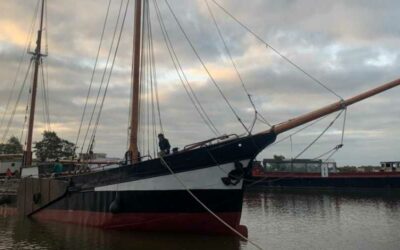By Corinna Goepfert
Main picture by Klassenzimmer unter Segeln
“As a way of measuring the contribution of the sailing industry to a sustainable future, we analyzed it in relation to the UN Sustainable Development Goals. These 17 goals were set in 2015 by the United Nations General Assembly and are to be achieved by 2030. The Goals are “the blueprint to achieve a better and more sustainable future for all”.
Sail Cargo and Travel Market Overview 2020
The second blog in series which looks at the broad framework of the SDG goals, as set out by the United General Assembly in 2015, and how sailing cargo meets them. The SDGs are an internationally recognised set of goals for a sustainable future and are a useful tool to indicate the level of change that sail cargo can help implement.
This blog looks at Goal 2 and Goal 13 which highlight no hunger and climate action and the link between them.
Goal 2 & Goal 13
No Hunger & Climate Action
Reducing hunger and engaging in climate action is not a question of either-or. Both climate change and hunger are interconnected. Both challenges, therefore, need solutions that acknowledge these interconnections.
International industrial shipping contributes significantly to global emissions. From 2007-2012 international shipping emitted on average 866 million tCO2e annually, 2,8% of global greenhouse gas emissions such as Carbon-Dioxide (CO2).1
Climate change is increasing pressure on resources and therefore on food supply chains especially for the Global South and Small Developing Island States. Countries that highly depend on agriculture will be most vulnerable to changes of climatic conditions.
On the other hand, agriculture, especially dairy and meat farming, is a sector with high greenhouse gas emissions such as nitrogen oxides (NOx). By reducing meat and dairy farming and focusing on producing plant-based food, more people could be nourished and less hunger would exist.
Sail cargo supports local communities that produce sustainable agriculture products. This shifts the focus away from mass production and monoculture while providing healthy food for the communities and for export transported by sailing ships.
Sailing vessels emit no pollution whilst sailing and sail cargo and travel look to reduce emissions where possible. Unlike the conventional shipping and travel industries, sail cargo has environmental issues at the forefront of its design and business activity. Sail cargo encourages a cleaner, more resilient economy and emphasizes the need to raise awareness of the climate crisis. In this way, the sailing industry contributes to the fight against global warming and indirectly, hunger.
1 IMO (Ed.). (2015). Third IMO Greenhouse Gas Study 2014: Executive Summary and Final Report.
Sign up to the EcoClipper newsletter to receive a copy of the Life-Cycle Analysis of the EcoClipper500 prototype.





